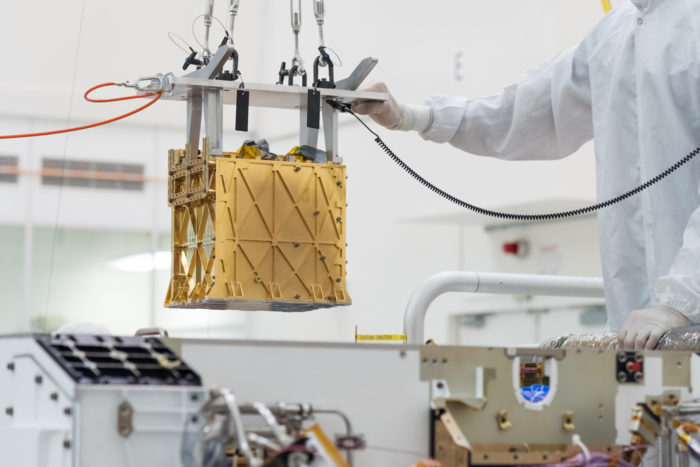Sep 01 2022
Making Oxygen on Mars

One of the major challenges of space travel is that there are no ready-made resources there. Mars, for example, has no food, shelter, oxygen, fuel, or power. It likely has water, but it’s not certain how much and how accessible. So for now any human mission to Mars will have to bring all recourses from Earth. Getting stuff to Mars is massively expensive, and resupply can take 6-9 months, during optimal launch windows. Keeping humans alive on Mars for any length of time is therefore a very tenuous and expensive endeavor.
One obvious solution is what NASA calls “in-situ resource utilization,” – using stuff that is already there. The Perseverance rover on Mars contains an experiment called MOXIE (Mars Oxygen In-Situ Resource Utilization Experiment) that has taken the first step toward the goal of in-situ resource use. MOXIE was developed by engineers at MIT, it is a lunch-box sized experiment onboard the Perseverance that makes oxygen from the Martian atmosphere. It is essentially a proof-of-concept, and if it works may be the forerunner of far larger machines in the future.
MOXIE draws in Martian air, filters out dust and other contaminants, then pressurizes it. It then applies a process known as the Solid OXide Electrolyzer (SOXE) to electrochemically convert CO2 in the Martian atmosphere into oxygen and carbon monoxide (CO). The elemental oxygen is then isolated in a chamber where it combines into breathable molecular oxygen, O2. MOXIE then releases the O2 and CO back into the atmosphere, but obviously working versions would collect these gasses for use.
The MOXIE experiments have demonstrated that the process works on Mars, a great first step, but did not end there. NASA also wants to know if MOXIE will work in a variety of conditions, at different temperatures, locations, atmospheric pressures, and lighting conditions. The experiments have now shown that MOXIE will operate at any time of day or night and during all of the Martian seasons. MOXIE has been fired up seven different times and in different conditions. The only condition it has not yet been tested in is dusk and dawn, where temperature changes can be rapid. If those times test out then they will have demonstrated that MOXIE can essentially run at any time one Mars.
Working versions of MOXIE will be much bigger, and designed to operate continuously. These could be delivered to Mars long before any human mission, and then run for years building up a supply of oxygen and CO. The obvious use for O2 is for humans to breath. But oxygen is also very useful for fuel – fuel needs to be burned with oxygen, and since there is no oxygen in space rockets carry their own oxidizer. For example, a hydrogen rocket will contain a tank of hydrogen and a tank of liquid oxygen to burn together. The goal is to create enough fuel (both propellant and oxidizer) for a return trip to Earth. Carrying the fuel all the way to Mars can get prohibitive.
What about the propellant itself? Well, the CO is also a highly useful molecule for this as well. Just combine it with hydrogen and you can make hydrocarbon fuels. You can also combine oxygen with hydrogen to make water, another useful substance to have on Mars. However, there is likely no significant free hydrogen on Mars, and if we bring hydrogen to Mars that defeats the whole “in-situ” thing. It’s more likely, therefore, that we will source hydrogen from water already on Mars. Fortunately, there appears to be a lot of water on Mars.
First, there is a lot of water ice on Mars, more than 5 million km^3 on or near the surface. But also there is liquid water in the form of perchlorate brines. Researchers have already developed a process to electrolyze these brines into oxygen and hydrogen without first having to purify it. Finally there is also water and hydroxyl groups bound up in minerals near the Martian surface.
From these sources we could have more than enough water to keep even a large Martian settlement going, and have enough left over to electrolyze into oxygen and hydrogen. These can be used directly for fuel. Or, we could combine the hydrogen with CO from a MOXIE device to form hydrocarbons. Hydrocarbons have many uses, not just fuel. For example it can be a feedstock for fertilizer.
However, fertilizer also requires nitrogen. On Earth we source our nitrogen from the atmosphere, which is 78% nitrogen. The Martian atmosphere is only 3% nitrogen, and its wispy thin (<1% of Earth’s). MOXIE works because the Martian atmosphere is 95% CO2. Still, in absolute terms that’s a lot of nitrogen, but it may not be practical to collect it. However, there are potentially other sources of nitrogen on Mars. A 2015 study found evidence for nitrates in Martian soil. That’s even better, because the nitrogen is already fixed.
Mars, therefore, seems to have all the raw materials we need for oxygen, fuel, water, and even fertilizer to grow food. MOXIE is just one piece of this puzzle, but it’s an important proof of concept. In fact, Mars may have more than enough raw materials. Once a Mars settlement is mature and self-sustaining, Mars could be a source from which to export hydrogen and oxygen. Mars may eventually be a critical resource hub supplying the inner solar system. Its relatively low gravity makes it a lot cheaper to get stuff off of Mars than Earth. Meanwhile, in-situ resource utilization will make human exploration of Mars far more feasible.






